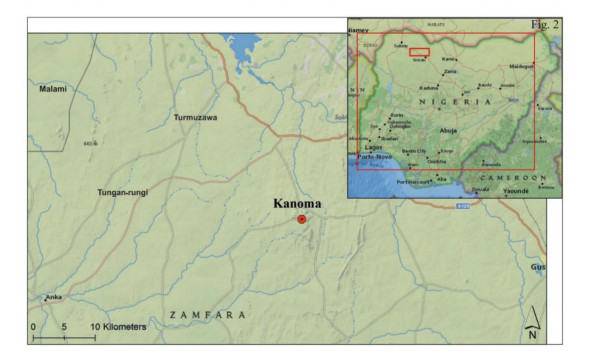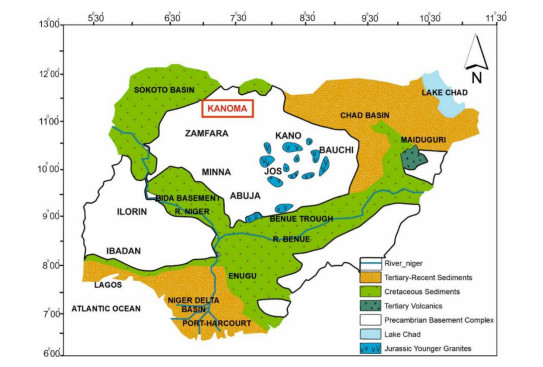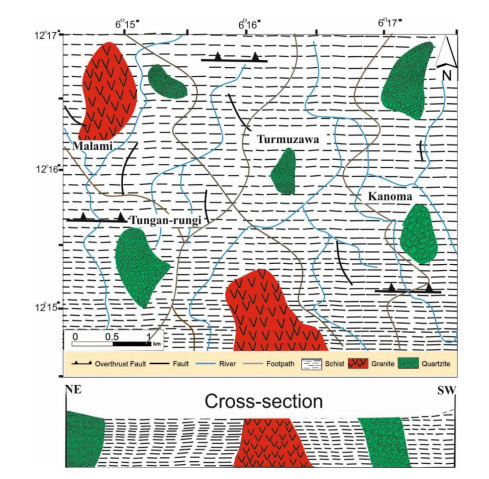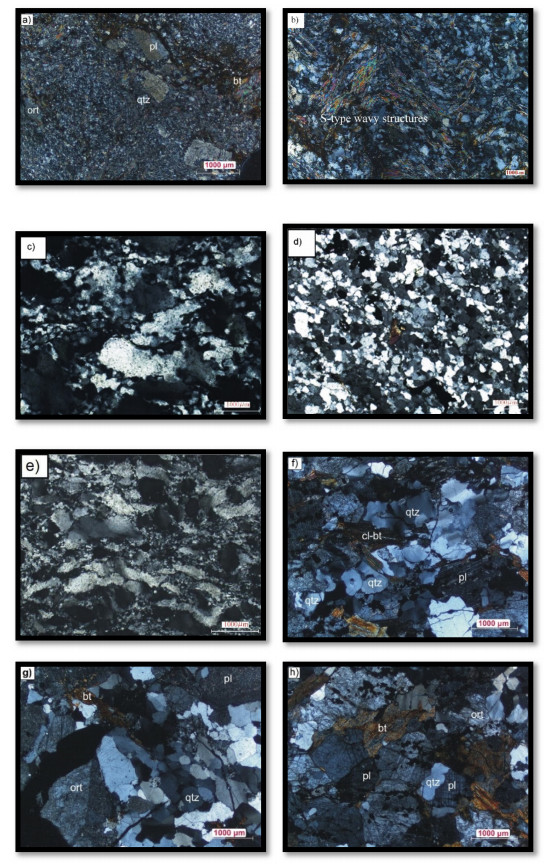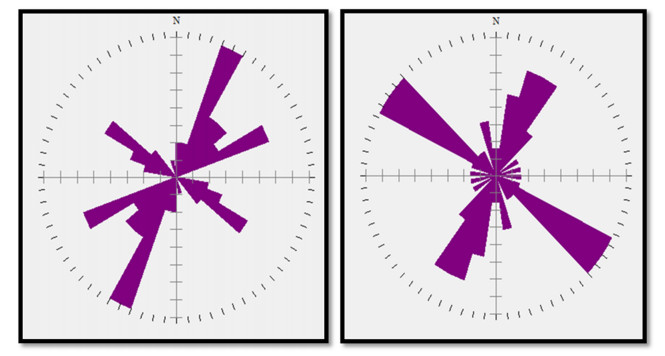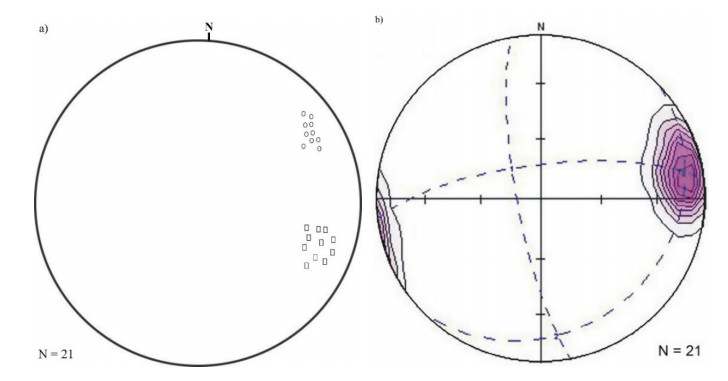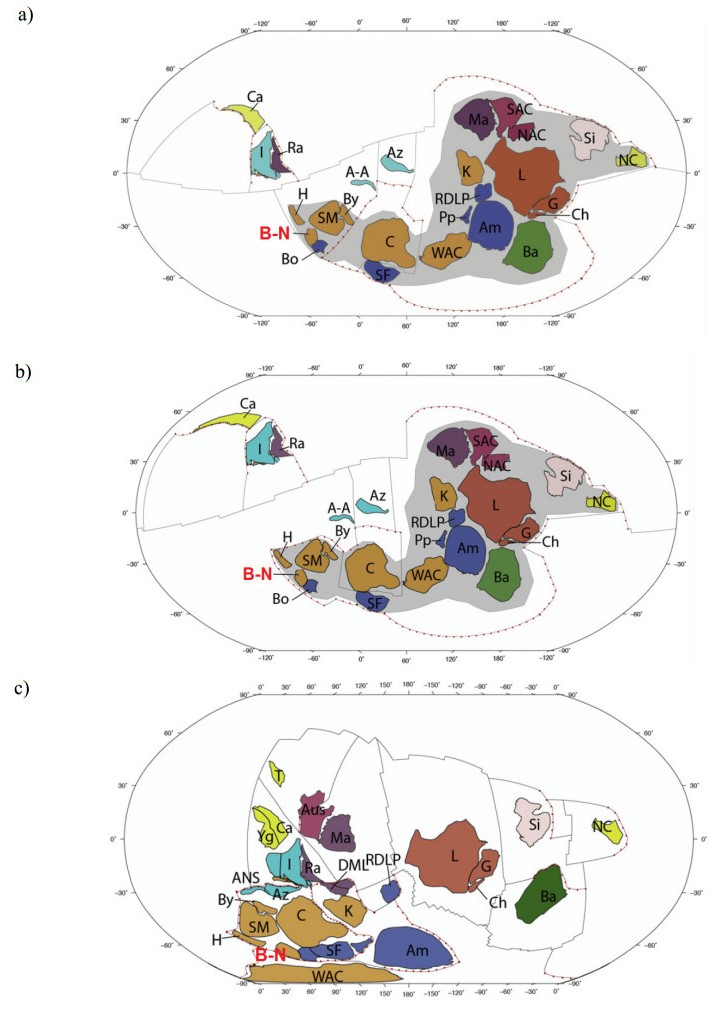1.
Introduction
The evolution of the Precambrian Basement rocks of the Benin-Nigerian Shield in the context of the Pan-African and Brasiliano Belts (Figure 1) is still enigmatic. Many researchers have therefore in recent times focused their attention on understanding the evolution of these basement rocks, especially in relation to the continental detachment of the African plate from the South American plate [1,2,3,4,5,6] and the subsequent opening of the South Atlantic Ocean during the early Mesozoic period (Figure 1).
The northwestern Nigeria Basement Complex forms part of the Pan-African mobile belt and lies south of the Tuareg Shield in the Benin-Nigerian Shield (Figure 1). The collision of the plate margin is believed to have led to the reactivation of the internal regions of the belts. There is increasing evidence that the rocks from the West African Craton and the Nigerian Shield may have been assembled from the Pan-African and Brasiliano mobile belts along the South Atlantic [7,8,9]. For instance, several continental blocks in Hoggar that lie in the Pan-African mobile belt show different histories of evolution, suggesting that they may have been imbricated fragments of adjacent terranes like the Nigerian Basement Complex. Additionally, in central-western Hoggar, most of the terranes are composed of a reworked pre-Pan-African basement and metasedimentary cover units, which have been largely unaffected by the Pan-African tectonic event [2]. Most outcrops of the Nigerian Province that probably are proximal peripherals of the central Hoggar units lie in sharp tectonic contact with the passive continental margin units separated by suture zones.
Also, the Borborema Province in NE Brazil forms a unique sequence of tectonic units that are part of the Late Proterozoic Brasiliano belt [10]. It is separated by a poly-system of steep and anastomizing shear zones of continental-scale (Figure 1). According to Caby [11], the NW part of the Late Proterozoic Brasiliano belt has a major lineament, which occurs beneath the Maranhào Basin. This appears to be rectilinear and can be traced to Sobral via a 2-km wide mylonite zone comparable to the adjacent West African block (Figure 1). The same researcher pointed out that this lineament is enough evidence for Precambrian correlation between the West African Craton and the South American Craton, which has set the basis for geological discourse on the evolution of most West African terranes.
The rocks in Kanoma, which occupy a greater portion of the northwestern segment of the Nigeria Basement Complex within the West African Craton have received little geological investigation though they have several economic potentials and interesting evolution history. Earlier studies only evaluated the general geology of northwestern Nigeria [1,12,13,14,15,16,17] but little is known about the petrography and structural setting of the underlying rocks in this area. Though the rocks are juxtaposed to prominent continental blocks in the context of the Late Mesozoic continental rift of the African plate from the South American plate, the previous researchers only gave a limited interpretation of the evolution of these rocks.
In this study, the first detailed petrographic and structural examination of the Precambrian basement rocks that crop out in Kanoma, northwestern Nigeria are presented to give an insight into the evolution and deformational episodes that pervaded them. Specifically, the study presents detailed observation and interpretation of geological features in the study area, which involve field and petrographic description and structural analysis to differentiate the rock units. This will help update the existing geological knowledge of northwestern Nigeria. The study also aims at comparing geologic histories, structures, and metamorphic evolution of Precambrian terranes across the South Atlantic to better constrain the probable geodynamic evolution of the northwestern basement rocks of Nigeria from the Pan-African and Brasiliano belts.
2.
Location and geological setting
The study area is in northwestern Nigeria mainly in Kanoma and its environs (Figure 2). It is geographically located on the coordinates 12°15′00″N to 12°17′00″N latitude and 006°16′5.4″E to 006°18′52″E longitude. It is situated southward of Gidan daji village in Maru local government area within Maru sheet 53 NE, Zamfara State. Kanoma lies within the Maru schist belt and consists of various rock types with different characteristics. As the northwestern segment of the Basement Complex of Nigeria, it is composed mainly of schist (Figure 3). The schist belt of northwestern Nigeria, which outcrops in Kanoma, occupies N-S trending syn-formal troughs with smaller bodies occurring in the migmatites and gneisses of the Basement Complex but due to erosion, they are only restricted to syn-formal troughs.
Geological studies on this continental block have been a subject of interest by numerous researchers [1,19]. The earliest researchers introduced the term Younger Granites to distinguish them from the Precambrian Older Granites [12]. Locally, the area is composed of psammatic to pelitic sediments of low-medium grade metasediments and meta-igneous rocks that have been unfolded into the Basement Complex during the Pan-African orogeny and are thus now preserved in troughs. The rocks in the area are mainly muscovite-biotite schist, quartz schist, ferruginous quartzite, kyanite schist, quartzite, marble, basic and calcareous schist, meta-conglomerates and metavolcanics (Figure 4).
The Nigerian Basement rocks range in age from Liberian to Eburnean, Middle Proterozoic, and Pan-African based on geochronological evidence. Recent studies suggest that two orogenic cycles affected the rocks in Nigeria [4,20]. According to these researchers [4,20], the first orogenic cycle is characterized by a period of sedimentation, deformation, metamorphism, folding, and syntectonic igneous activities that stretch E-W, accompanied by regional metamorphism during which the Eburnean orogeny was active until 1850 Ma. The Basement Complex is composed of Archean rocks, which were deformed and modified several times before the Pan-African orogeny. During this time, a marginal basin environment developed in the Benin-Nigerian Shield due to plume-related tectonics that led to back-arc extension, creating a paleo basin of deposition of the schist belt. As a result, the Nigerian Basement Complex is poly-cyclic. Evidence from other parts of the Basement Complex suggests that the Migmatite-Gneiss Complex may be as old as Archean [21].
The second orogenic event also known as the Pan-African orogeny started ~ 650 Ma and ended by 580 Ma. This resulted in the deformation, reactivation of pre-existing rocks, and synorogenic plutonism. The Pan-African deformational event in Nigeria was first dated by Grant [12] who obtained an Rb/Sr isochron age of 580 ± 70 Ma on the older granites in northwestern Nigeria. The first reliable radiometric data for the schist belt was reported by Ogezi [22] who obtained an Rb-Sr isochron age of 1065 ± 64 Ma from phyllite of the Maru schist belt. Ajibade [15], however, reported that the rocks in the schist belt are all of the same age and that the 1100 Ma age obtained from Birnin Gwari schist formation must represent a later date from mild heating during the emplacement of the Pan-African granitoids and the deposition of the supracrustal rocks must have ended before this period.
The geochronology of the Maru schist belt suggests that the schist belt was laid down on the older basement and later unfolded into the basement rocks [22]. The Maru schist belt, where the Kanoma basement rocks are located belongs to the Pan-African age group. The older granites here are generally believed to have been emplaced during the Pan-African orogeny. The rocks comprising the older granite suites range in age from 750–450 Ma [15]. The emplacement of the older granites occurred due to block collisions within the Nigerian Shield [5,6,23]. The geochronology and tectonic events of the basement rocks in Nigeria are summarized in Table 1.
3.
Materials and methods
The fieldwork for this study included a reconnaissance survey where first-hand information regarding the geology of the area was collected from the field. This was followed up by detailed geological field mapping using Compass clinometer-Global Positioning System (GPS) traversing method. The compass clinometer was used to measure trends and dips of lithologies and other structural features on outcrops.
The data obtained in the field mainly dip and strike of the lithological units and structures were plotted on the 1: 25,000 field sheet (53 Maru NE) of the Kanoma area. It was later transposed onto ArcGIS 10.2.2 software and then digitized for good visualization. The structural measurements were analyzed and displayed using rose diagrams and equal-area stereographic plots. Ten (10) thin sections of the samples collected from the field were analyzed with a polarized light microscope at the mineralogy laboratory of the Department of Geological Engineering of Muğla Sitki Koçman University, Turkey. Plate reconstruction models [26] for the Precambrian period were used in constraining the geodynamic evolution of the studied rocks.
4.
Results
4.1. Field mapping data
Kanoma and its environs form part of the Basement Complex of northwestern Nigeria, which is predominantly made up of schist, quartzite, and granites. During the fieldwork for this study, the following lithological observations were made.
4.1.1. Schist
Schists are the most abundant lithologic units in the study area found in lowlands and along stream channels. They are mostly fine-grained with dark grey to light brown colours (Figure 5a, c). Simple folding locally occurs in the schist (Figure 5b). The schists occur as low-lying ridges and mostly along river channels in the southwestern part of the area (Figure 5d). They constitute about 90 % of the rocks in the study area in terms of areal distribution. Most of the schists are usually weathered completely into lateritic soil, sometimes their remnants are expressed by highly resistant cobbles and pebbles of quartzite that occur as ridges with variable textures (Figure 5a). The foliation in the rocks is well defined by the alignment of mica, which occurs as flakes impacting the high degree of schistosity on the rocks (Figure 5c, d). The schist in the study area is part of the Maru schist belt and it shows an N-S orientation with the angle of dip generally within the range of 40°–85° in both directions. The schists are weakly foliated on the mm scale. Quartz veins were observed in the study area as veins in-filled with quartz.
They occur along zones of fractures and joints. They are associated with the schists mostly trending perpendicular to the direction of the schists with cross-cutting attitudes probably marking the end of the tectonic activity in the area. Such veins were common on outcrop surfaces and range in size from a few millimeters to a few centimeters.
4.1.2. Quartzite
The quartzites in the study area are white to brown to pinkish (Figure 5e, f). They are observed as ridges in some locations (Figure 5e) south of Kanoma village and towards the north of Turmuzawa village and are somewhat fractured concordially, which may be a result of tectonic activities since quartzite is brittle. They are also characterized by quartz veins and traces of mica running through them (Figure 5g, h).
4.1.3. Granite
Meta-granitic outcrops of medium grade are observed southwest of Tsalge village (Figure 5i). In hand specimens, they are light grey to generally brownish when fresh signifying the presence of relatively high feldspars and biotite mica, while appearing yellow-brown when weathered. They constitute about < 5% of the varying lithologies in the area. Translucent quartz with white and pinkish feldspars, black biotite, and silvery flecks of muscovite is also seen with a hand lens. The contacts with metasediments are largely inferred as contacts covered by secondary alluvium and laterites. They are mainly low-lying with quartzofeldspathic veins of varying widths.
The presence of fracture was noticed in abundance in various directions. In some other locations north of Anguwar Malami and in Tungun-rungi village, they are generally unfoliated with abundant xenoliths and lenses of dark material and magmatic segregation (Figure 5j, k). The meta-granite is slightly sheared around the Malami area (Figure 5l).
4.2. Petrography
Two schist samples, four quartzite samples, and four granite samples were subjected to petrographic analyses. Modal analysis of the mineralogical composition in all these samples is by visual estimation. The results are presented below:
4.2.1. Schist
The schist is fine-grained equigranular with prismatic to platy brown colored biotite (42%) that is pleochroic from light to dark brown with a pleochroic halo in places (Figure 6a). Quartz grains about 48% of the mineral mass are colorless. Biotite is partly converted to chlorite (5%). Feldspars (3%) are occasionally present and the associated minerals include opaques. Muscovite commonly occurs in golden brown. The schist locally displays wavy structures (S-type) indicating the effect of the Pan-African deformational episode that is reflected in the presence of simple folding (Figure 6a, b).
4.2.2. Quartzite
Quartzite is mainly composed of quartz (95%). Under PPL the quartz appears colorless except for the presence of opaque minerals which make up 5% of the total mineralogical composition (Figure 6c, d). Under XPL, the quartz grains range in color from white, and gray to black and form a tight interlocking network (Figure 6d). They also show wavy extinction with recrystallized quartz at the crystal boundaries (Figure 6e).
4.2.3. Granite
This displays medium grain granular hypidiomorphic texture. The main constituents are quartz (30%), biotite (25%), alkali feldspars (orthoclase—22%), plagioclase feldspars (15%), microcline (3%) and opaques (<5%) as accessories. The quartz appears colorless, with low relief with the anhedral habit (Figure 6f). It appears cloudy with undulose extinction (Figure 6g). Biotite shows brownish colors and is strongly pleochroic from dark brown to straw yellow slightly altered to Fe-chlorite (Figure 6h). It occurs as subhedral crystals with moderate relief and good cleavage in plane-polarized light. It has straight extinction and exhibits a high birefringence. Alkali feldspars, mainly orthoclase, are yellow-pink, subhedral with medium relief.
4.3. Structural and deformational features
The various structural features that are observed in the study area include; joints, foliations, folds, faults, and metamorphic structures. The regional trends of most of these structures are generally NNE – SSW, indicating an imprint of the Pan-African Orogeny. The rocks in the area generally display the regional N-S trend, which represents the final imprints of the Pan-African orogeny.
4.3.1. Joints
Almost all the rocks in the mapped area are jointed to a certain degree and the joints differ in intensity depending on the rock type. The joints occur as horizontal, inclined, and vertical defining a dendritic pattern. The weathering, topography, and drainage pattern of the area are highly influenced by joints. The majority of the joints strike in the N-S direction and are parallel to one another and some of them are perpendicular forming a joint set (Figure 7a). Some of the joints are filled with quartz, thus quartz veins while some of the joints are enlarged by plant roots. The trends of the joints (42 measurements) on the outcrops are shown on the rose diagram (Figure 8a).
4.3.2. Quartz veins
The Quartz veins found in the area mostly trend in a general N-S direction with cross-cutting attitudes probably marking the end of the tectonic activity in the area. Such veins were common on outcrop surfaces (Figure 7b, c). They are composed mainly of quartz and range in size from a few millimeters to a few centimeters. The trend of the veins is shown on a rose diagram (Figure 8b). The total data on the quartz veins running through the outcrops were 33 resulting in an average strike of 088° and a degree of clustering of 2.30 with a mean dispersion of 0.58.
4.3.3. Folds
The main fold locally observed in the study area is a simple anticline micro fold found on the schist which is not tortuous (Figure 7d). They were formed during metamorphism as a result of compressive stress which was intense.
4.3.4. Faults
The occurrence of faults in the study area was little. These are fractures along which there is observable movement. They were observed in places where quartz vein has been displaced along the fault planes. The faults observed are strike-slip faults with a dextral sense of displacement (Figure 7e).
5.
Discussion
Detailed interpretation of the petrographic and structural features of the investigated rocks in the study area is presented in this section. The metamorphic history of the rocks is determined using the mineral assemblages observed in the thin sections and the major structural features. These features are then correlated with the probable equivalent units in the Pan-African and Brasiliano belts along the South Atlantic.
5.1. Metamorphism, tectonics, and structural evolution
The Basement Complex rocks in NW Nigeria exposed in the Kanoma area have undergone many cycles of metamorphism; hence, they are poly-metamorphic [1]. This can further be supported by both field and petrographic evidence. The undulose extinction exhibited by quartz and the inclusions of tiny quartz and biotite grains shows that they are original pre-tectonic minerals that have been recrystallized. The partial alteration of feldspar into sericite and the preferred orientation of biotite shows the activity of syntectonic processes. The mineral paragenetic sequence of quartz + muscovite + biotite + orthoclase + plagioclase + chlorite common among the investigated rocks, therefore, suggests that the rocks in Kanoma have undergone medium-grade metamorphism. The evidence of metamorphism in the studied rocks is also shown by the presence of structures such as foliation, schistosity, folding, fracture, and faulting. From these signatures and the type of rocks within the area, it can therefore be established that the study area was affected by a medium-grade regional type of metamorphism.
Structural overprinting relations recognized within Kanoma and its environs allow the separation of the geologic structures into three successive Pan-African deformational events (D1–D3). D1 fabrics are very sparsely distributed in the area, and are manifested by simple anticline micro folds in the schist (Figure 5b). The D2 structures are the predominant ones in the area comprising the N-S directional joints and faults (Figure 7a). The D3 phase of deformation in the rocks of Kanoma is a progressive one, which started as N-S high angle thrusts and thrust-related folds that resulted from the NE–SW contraction during the orogenic episodes (Figure 5b). Using 42 measurements of the azimuths of joints in the granitic outcrops, a dominant NNE – SSW, with a subordinate SE – NW and NEE – SWW trends are indicated on the rose plot (Figure 8a). Statistically, the average strike of the joints observed in the area is 064° with a degree of clustering and mean dispersion values of 3.42 and 0.71, respectively. The joints from Figure 6a, are a set of non-systematic joints considering the angle at which the joints intersect or crosscut each other. The other rose plot (Figure 8b) is showing trends of the quartz veins close to being a system. There are, however, minor different stress fields aside from the two dominant trends. These trends indicate that they are pervasive as they are more of systematic quartz veins (Figure 8b). Figure 8b has some trends similar to that of Figure 8a (non-pervasive for its non-systematic nature). The joints are most likely to have been generated following the intrusive event of the quartz veins.
The level of deformation in Kanoma led to the development of foliations in the schists. The foliations generally trend from N to NNE with the first set (S1) locally dipping moderately to the western part of the area (Figure 9a, b). In some places, the early structural fabrics have been reworked into steeply dipping foliations (S2) in the schist (Figure 9a, b). The evolution of these deformational mechanisms from moderately dipping foliations to steeply dipping foliations along an N to NNE- trend is associated with late orogenic uplift and exhumation following oblique convergence during the Pan-African orogeny.
5.2. Regional evolution of the basement rocks in NW Nigeria
Based on the fieldwork carried out in the study area and previous geological mapping of the northwestern segment of the Precambrian Basement Complex in Nigeria [18,25,27], the chronological order of evolution of the rocks in Kanoma can be constrained. Schist is believed to be the oldest rock type in the study area. It is believed to be part of ancient Eburnean orogenic metasediments dated about 1000 Ma (Table 1).
From the mode of occurrence in the field, it was observed that the schist was formerly occurring as high ridges, but it became weathered, forming the base on top of which the quartzite occurred. The quartzite may have been emplaced at ~930 Ma (Table 1). Its occurrence in the field is closely associated with schist. The occurrence is complemented by a clear contact between schist and quartzite (Figure 7f). It is also observed that the quartzite occurs mostly as ridges overlying the schist further constraining their close association. Granite is the youngest rock type in the study area and it probably formed during the Pan-African orogeny close to the end of 580 Ma, which resulted from the deformation, reactivation of pre-existing rocks, and syngenetic plutonism [12] and has a gradational contact with the schist (Figure 7g). Therefore, it can be established that the oldest rock type in the study area is schist, after which quartzite was formed and granite being the youngest rock type intruded the older rocks (Figure 4). The intrusion of the granitic magma into the schist and quartzite may have altered their original compositions leading to contact metamorphism of the schist and quartzite. This led to schistosity within the schist as observed in the field and the distortion of the petrographic features of the schist and quartzite. Moreover, according to Egbuniwe [1], the Kanoma pluton and its associated country rocks show distinct features, which indicate that successive pulses of magma that ascended from a centrally placed duct, ballooning and deforming the adjacent metasedimentary rocks, emplaced the pluton.
The igneous complexes of Western Hoggar emplaced at about 1.0 Ga were controlled by an N-S trending fault system that was later reactivated during the Pan-African orogeny [28]. They can be correlated with the rocks cropping out in the Kanoma area based on their overlapping tectonic and deformational signatures. The intrusion of the alkaline metamorphic dyke complex in an N-S directional zone of weakness in the Hoggar Massif suggests a pre-metamorphic paleorift system within which the schist belt of NW Nigeria might have evolved.
The structural features of the granitoids in Borborema province of the Pan-African fold belt of NE Brazil are also in consanguinity with the late-stage granites in Kanoma that intrude the schist and quartzite. The limited data of the Kanoma rocks however constrain this correlation. During the Late Paleoproterozoic in NE Brazil and Nigeria, the emplacement of rift-related magmatic rocks occurred between 1.85–1.73 Ga [29]. However, only a few Paleoproterozoic ages are readily available for rocks in Nigeria. For example, Paleoproterozoic granite gneiss in southwestern Nigeria [12,30,31] and migmatite gneiss in northern Nigeria [13,25] have been reported. The rock assemblage in Kanoma is reminiscent of the Borborema province in NE Brazil [29,32]. They are both characterized by younger granitic intrusions cutting through diverse metamorphic units including schist, quartzite, and meta-greywackes. The tectonic style of the Maru schist belt, which Kanoma sits on, is correlative to that of the Northern Borborema province. They are generally represented by syn-metamorphic upright folding synchronous with the emplacement of syn- to late kinematic plutons preferentially aligned along transpressive belts [29]. The previous regional correlation carried out by Caby [11] and later presented by dos Santos et al. [7] suggests that the aluminous Sao Joaquim quartzite nappe correlates very well with the NW nappe vergence in Nigeria and the Atacora nappe exposed in the Benin-Togo Shield.
Besides, the basement of the Brasiliano/Pan-African belts is characterized by Archean rocks in the northern margin of the Araguaia belt [32] that is adjacent to the eastern segment of the Amazonian Craton and is interpreted to be the eastern prolongation in northwestern Nigeria Province. The predominant Pan-African magmatic activity in Nigeria can be compared with the central and southern terranes of the Borborema province [8,9,33]. Based on geochronological ages (ca. 2.1 Ga) of old fluviodeltaic deposits in the Amazonian, Ledru et al. [34] proposed that the São Francisco/Congo and West African cratons amalgamated together and formed a single landmass close to the end of the Transamazonian/Eburnean orogeny. This is in agreement with the model proposed by Ngako and Njofang [35], which involves a three-plate collision model comprising three main landmasses; the São Francisco/Congo craton, the eastern Saharan block, and the West African Craton (Figure 1). The orientation of this collision in an N-S direction (Figure 1), coupled with the intense penetration of the Saharan rigid block into the active margin of the São Francisco/Congo craton before the end of the Pan-African Orogenic event led to the intense poly-deformation of adjacent terranes such as the northwestern Basement Complex of Nigeria where the present study is focused.
In the preceding years, many researchers began doing correlative studies in these cratonic provinces to constrain their geodynamic evolution and similarities. This led Norcross et al. [36] to discover similarities in geological features and gold mineralization along the northern margin of the Amazonian Craton and the West African Craton, which was enough evidence for the Paleoproterozoic supercontinent hypothesis of Ledru et al. [34]. However, the name of this supercontinent remained mysterious until Rogers [37] suggested the name Atlantica, which included the Rio de la Plata Craton. The inclusion of the Rio de la Plata Craton in the Atlantica is supported by the dominance of the Paleoproterozoic crust and the existence of 1.7 Ga dike swarms and Rapakivi granites.
Accordingly, the presence of Atlantica in the basement of Borborema is further supported by the widespread abundance of 640–620 Ma Brasiliano granitic plutons and orthogneisses in central Ceará [33] and the southern peripherals of the Borborema province [38]. The emplacement of the granite suites at this time is contemporaneous with the first deformation event. However, the second deformation episode occurred at the dusk of 600 Ma, which caused strain partitioning between an anastomosing network of transcurrent shear zones and diverse levels of deformation accompanied by the intrusion of 590–570 Ma rocks [38]. These two deformational events were probably continuous in time because some plutons record finite strain patterns indicative of these events. It has been recently reported in Nigeria that two finite strain fields of similar ages and structures as in the Borborema Province pervaded the Atlantica in the basement of Nigeria. This implies that the Brasiliano/Pan-African orogeny may have lasted 70–80 Ma with the emplacement of Post-orogenic granites (540–530 Ma) although deformation in other Brasiliano/Pan-African belts is still active.
5.3. Evidence of evolution by plate models
Merdith et al. [26] whilst studying the global reconstruction of the Neoproterozoic using full-plate models suggested that between 1000–950 Ma, there was a transform boundary connecting a spreading ridge outside the Sahara Metacraton. This influenced subduction between the Sahara Metacraton-Borborema Plate and the Congo-São Francisco Plate. The authors stated that despite the complexity of the Hoggar Shield area and the cover of the Sahara Desert, there was minor subduction preserved in these areas. The subduction zone represents the distal extensions of the Circum-Rodinia subduction girdle linked to the distal subduction outside the West Africa-Amazonia-Baltica Plate through an inferred subduction zone adjacent to São Francisco (Figure 10a).
In the southern peripheral, the subduction zone was active between 900 and 800 Ma preserved in juvenile arcs on the western flank of the Borborema Province (Figure 10b). This suggests that by the mid-Tonian the Sahara Metacraton was surrounded by large subduction zones [26]. The subduction zone outside of Borborema is offset slightly but otherwise occurs along the same border as the inferred subduction zone adjacent to the São Francisco Craton due to spreading in the Araçuai Basin (Figure 10b; [26]). It is yet unknown how close the Hoggar Shield and the Borborema Province were to the Sahara Metacraton because of the absence of palaeomagnetic data and major crustal reworking during Gondwana's amalgamation [26]. The subduction zone may be close to Borborema due to the convincing evidence of earlier subduction preserved there and slightly more distal from Hoggar due to the later evidence of subduction.
Before the end of 600 Ma, most of the subduction zones that initiated the Gondwana amalgamation had developed. But, the opening of the Iapetus and the drift of Amazonia and the West African Craton into the Congo-São Francisco Plate and the Sahara Metacraton initiated the youngest Gondwana-forming orogenies (Figure 10c). From the plate tectonic models, the convergence between the Borborema Province and the West African-Benin-Nigerian Shield involved the closure of an oceanic realm with subduction polarity to the southeast beneath the northwestern part of the province. Consequently, it seems likely that the Pharusian Ocean was continuous from the Hoggar Province in West Africa into South America during the late Neoproterozoic. It is believed that much of the sediment that formed the schists and quartzites in this study was derived from sources now incorporated into the Borborema Province or lateral equivalents in Hoggar. The Neoproterozoic granitoids in the Benin-Nigerian Shield may represent a major batholith within Palaeoproterozoic hosts, much larger than, but similar to Neoproterozoic granite occurrences in NE Brazil.
6.
Conclusions
The following conclusions are drawn from the current study;
√ Kanoma is dominated by schists and quartzites with younger granitic intrusions in some localities.
√ The schists are interpreted to be the oldest (~1000 Ma), followed by the quartzites (~930 Ma) and then the granites (~580 Ma) based on previous geochronological studies, field, and petrographic evidence.
√ The geochronological ages suggest that the rocks were probably affected by two orogenic episodes known as the Eburnean orogeny and the Pan-African orogeny.
√ The litho-structural features suggest that the rocks were pervaded by three successive deformational events (D1–D3), which are Pan-African in age, implying that the deformation is penecontemporaneous with the emplacement of the granites.
√ The abundance of fracture and folding structures on the quartzite and schist shows evidence of medium-grade metamorphism and plastic deformation in the area.
√ The outcrops also display N-S trending joints with quartz veins running through the granites and the schist, which are interpreted to be imprints of the Pan-African orogenic event.
√ The metasedimentary rocks may have formed in subduction zone settings and to a larger extent, the younger granite intrusions. But collision-related granites are not uncommon in the area.
√ The studied rocks are correlative to those in the Pan-African and Brasiliano belts along the South Atlantic based on similarities in their geological, geochronological, structural, and tectonic styles.
Conflict of interest
On behalf of both authors, the corresponding author states that there is no conflict of interest.
Acknowledgment
The authors acknowledge the Editor and three anonymous Reviewers who helped in improving the quality of this study.
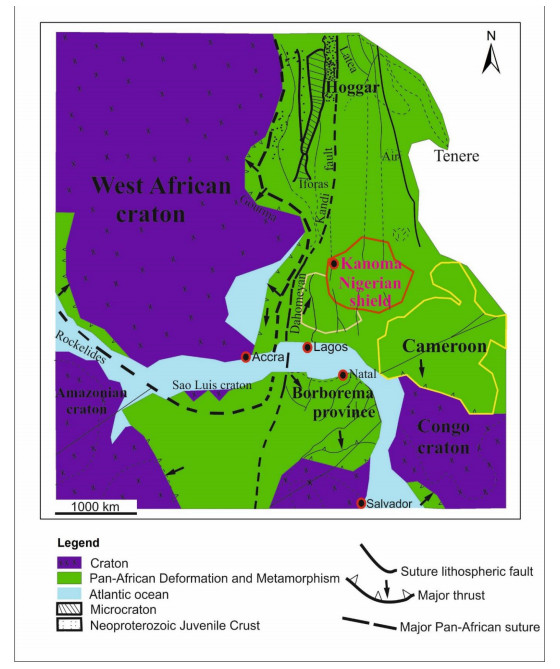









 DownLoad:
DownLoad:
